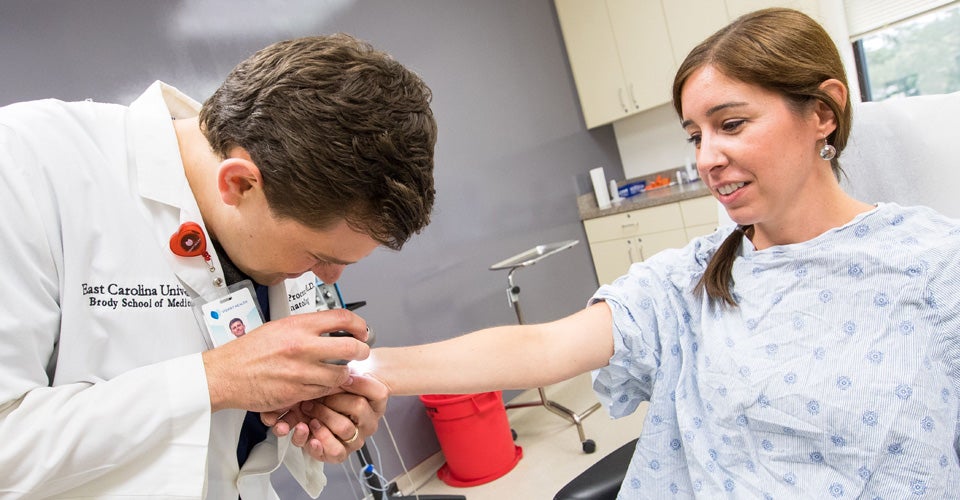TANNED SKIN IS DAMAGED SKIN
Dermatologist says sun exposure lasts a lifetime
East Carolina University dermatology resident Dr. Randall Proctor likes to take his family to the beach, but he’s careful to make sure they’re protected from the sun’s rays.
“Don’t get me wrong; being in the sun feels great. It definitely increases mood,” Proctor said. “But all it takes is more than 15 minutes and you’re starting to rack up damage on your skin cells that will never go away.”
Within seconds, Proctor said, the sun starts to affect skin cells. He said you’ve probably forgotten about your most recent sunburn, but that sunburn damage lasts a lifetime.
“Ten, 20, 30 years down the line, they’re (patients) showing up at the dermatologist not remembering that sunburn at all, but they have several growths or at least one bad growth that has to be cut off or removed surgically,” he said.
The skin cancer statistics are worrisome. Proctor said one in five Caucasians will get skin cancer in their lifetime. In eastern North Carolina, it’s probably closer to one in three for white males and one in four for white females, he added. On top of that, it’s estimated that one in 50 whites are getting melanoma (the most serious type of skin cancer) which is at record levels, he said.

Dr. Randall Proctor examines a patient for skin abnormalities.
Non-white individuals also have to worry about skin cancer. Proctor said that while skin cancers are far more common in fair-skinned people, African Americans, Asians and Hispanics also get skin cancer. He added that many times skin cancer goes undetected longer in patients with darker skin due to the stereotype that only white people get it.
Proctor said people should pay special attention to moles that are changing or irregular – those that are asymmetrical, have uneven borders, are multicolored or large. He also recommends seeing a physician for a bump on the face that bleeds or is scaly and does not heal after six weeks, or a new bump that appears to be growing for more than a month or two.
Proctor said the dangerous skin cancers are more commonly seen on the backs of men and the lower legs of women. The most common area for skin cancer in general, though, is the head and neck.
“Those are the places where you pay for it later with a gnarly scar from a dermatologist or surgeon (after removing the cancer),” Proctor said.
To protect yourself, he urges you to seek shade, but if you have to be in the sun to wear protective clothing and hats. He also advocates using a water-resistant, broad-spectrum sunscreen with an SPF of at least 30. Proctor said to reapply sunscreen every hour if you are getting wet or are sweating and every two hours if you stay dry.
“Looking good now comes with a price later. The sun definitely ages the skin, and that is very difficult to reverse,” Proctor said. “The damage that comes from that excessive sun exposure stays with you forever.”

Dr. Randall Proctor examines a patient for skin abnormalities.